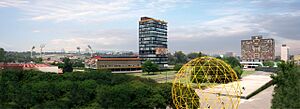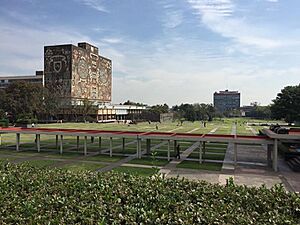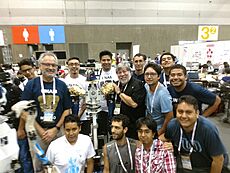National Autonomous University of Mexico facts for kids
|
Universidad Nacional Autónoma de México
|
|
 |
|
| Latin: Universitas Mexicana | |
|
Former names
|
National University of Mexico (1910–1929) |
|---|---|
| Motto | Por mi raza hablará el espíritu |
|
Motto in English
|
"Through my race shall the spirit speak" |
| Type | Public research university |
| Established | 22 September 1910 |
| Founder | Justo Sierra Porfirio Díaz |
| Endowment | US$3.0 billion (2023) |
| Rector | Leonardo Lomelí Vanegas |
|
Academic staff
|
42,190 (as of 2023[update]) |
| Students | 373,340 (2022–2023 academic year[update]) |
| Undergraduates | 233,360 (as of 2023[update]) |
| Postgraduates | 32,550 (as of 2023[update]) |
|
Other students
|
106,863 (high school) (as of 2023[update]) |
| Address |
Av. Universidad 3000, Col. Universidad Nacional Autónoma de México, C.P. 04510, Ciudad Universitaria, Coyoacán
,
,
Mexico
19°19′44″N 99°11′14″W / 19.32889°N 99.18722°W |
| Campus | Urban, 7.3 km2 (2.8 sq mi), main campus only |
| Colors | Blue and gold |
| Nickname | Pumas |
|
Sporting affiliations
|
41 varsity teams |
| Mascot | Goyo |
| Official name: Central University City Campus of the National Autonomous University of Mexico (UNAM) | |
| Type: | Cultural |
| Criteria: | i, ii, iv |
| Designated: | 2007 (31st session) |
| Reference #: | 1250 |
| Region: | Latin America and the Caribbean |
The National Autonomous University of Mexico (Spanish: Universidad Nacional Autónoma de México, or UNAM) is a major public university in Mexico. A public university is funded by the government, so students can attend at a low cost. UNAM is also a research university, meaning its professors and students work on discovering new things in science, technology, and other fields.
With over 370,000 students, UNAM is one of the largest universities in the world. It has many campuses in Mexico City and across Mexico. It even has locations in nine other countries. The university also runs 34 research centers, 26 museums, and 18 historic sites.
UNAM's main campus in Mexico City is called Ciudad Universitaria, which means "University City." Part of this campus is a UNESCO World Heritage site because of its amazing architecture and art. Many famous Mexican artists helped design and decorate the buildings.
The university is known for its excellent education. All of Mexico's Nobel Prize winners have been students or graduates of UNAM. The university also produces over a quarter of all scientific research papers in Mexico.
Contents
History of UNAM

The modern version of UNAM was founded on September 22, 1910, by Justo Sierra. At the time, he was Mexico's minister of education. He wanted to create a new, modern university that was not connected to the church. His goal was to combine several smaller colleges in Mexico City into one large, national university.
This new university was different from its older version, the Royal and Pontifical University of Mexico. The old university was started in 1551 but was closed in 1865. Justo Sierra wanted a fresh start with modern ideas.
Early Challenges
The university faced problems from the start. The Mexican Revolution was happening, which created a lot of political change. The government had a lot of control over the university, which caused issues.
In 1912, students held their first strike to protest new exam rules. A strike is when people refuse to work or attend class to demand a change. In the 1920s, more student strikes helped the university gain autonomy. Autonomy means the university could make its own decisions without government control. The university's leader, called the rector, became the final authority.
Student Movements
UNAM has a long history of student activism. In 1966, another big student strike happened, again over exam rules.
In 1968, students at UNAM and other universities led a series of protests known as the Mexican Movement of 1968. They were unhappy with social issues in the country and the government's spending on the 1968 Summer Olympics. The protests grew larger over the summer. During one protest in Tlatelolco, the army was sent in, and the situation turned violent. Many people were hurt or arrested. Just ten days later, the Olympic Games opened at the university's stadium.
The last major strike was in 1999. Students shut down the campus for almost a year to protest a plan to charge tuition fees. The strike ended when police entered the campus.
Explore the Campuses
University City

"Ciudad Universitaria" is UNAM's main campus in the southern part of Mexico City. It was built in the 1950s on a field of ancient hardened lava. The campus is so big that it's like a small city. It has its own rules, police, and transportation.
The campus was designed by some of Mexico's most famous architects. It includes about 40 schools, a cultural center, a large library, museums, and an ecological reserve. In 2007, the main campus was named a UNESCO World Heritage Site for its cultural importance.
Other Campuses
Besides University City, UNAM has many other campuses. Some are in the Mexico City area, while others are in different states across Mexico. These smaller campuses often focus on research and graduate studies.
UNAM also has schools in other countries, including the United States and Canada. These schools teach Spanish, English, and Mexican culture to students from around the world.
Museums and Special Buildings
- Palacio de Minería: This beautiful old building in downtown Mexico City was once the School of Engineering. Today, it hosts book fairs and events. It has exhibits about mining and science history.
- Casa del Lago: Located in Chapultepec Park, this "House of the Lake" is a center for cultural activities like dance and theater.
- Museum of San Ildefonso: This historic building is known as the birthplace of the Mexican muralism art movement. It has amazing murals painted on its walls by famous artists like Diego Rivera.
- Chopo University Museum: This museum has a unique design with large glass panels and iron towers designed by Gustave Eiffel (who also designed the Eiffel Tower). It shows modern art exhibits.
- National Astronomical Observatory: Located on a mountain in Baja California, this observatory has powerful telescopes that astronomers use to study the stars.
Academics at UNAM
UNAM offers many subjects to study, from engineering and law to art and medicine. Students can earn bachelor's degrees, master's degrees, and PhDs. The university also runs several high schools in Mexico City.
UNAM also has an "Open University and Distance Education System." This allows students to learn online or with only a few in-person classes. This makes it easier for people who cannot attend classes on campus every day.
According to most rankings, UNAM is the best university in Mexico and one of the top 10 in Latin America.
Scientific Research
UNAM is a leader in scientific research. The university is home to many of Mexico's top research centers. Scientists at UNAM study everything from astronomy and physics to ecology and medicine.
The university has made important discoveries in many fields. For example, its researchers do important work on artificial intelligence and alternative energy. UNAM's robotics team often wins first place in international competitions.
UNAM has a supercomputer named Miztli, which helps scientists solve complex problems. The university also has a research ship, called "El Puma," for studying the ocean.
Pumas Sports Teams

UNAM's sports teams are called the Pumas. The university's mascot is a puma named Goyo.
The most famous Pumas team is the professional soccer club, Club Universidad Nacional. The team plays in Liga MX, Mexico's top soccer league. Their home is the Estadio Olímpico Universitario, the same stadium used for the 1968 Olympics.
UNAM also has a very successful college football team. They have a famous rivalry with the team from the National Polytechnic Institute (IPN), another large public university in Mexico.
University Culture
Seal and Motto
The university's seal was designed in 1920 by José Vasconcelos. It shows a Mexican eagle and an Andean condor over a map of Latin America. This design represents the unity of Latin American people.
The motto, "Por mi raza hablará el espíritu," means "Through my race the spirit shall speak." Vasconcelos wanted this motto to show that the university would create a new culture based on knowledge and freedom.
Puma Logo
The famous Pumas logo was created in 1974. It shows the face of a puma made from the shape of a closed fist. The blue triangle behind the puma represents the three main goals of the university: education, research, and sharing culture.
Famous People from UNAM
Many important people have studied or taught at UNAM.
Nobel Prize Winners
All three of Mexico's Nobel Prize winners are connected to UNAM:
- Alfonso García Robles (alumnus) - Nobel Peace Prize, 1982
- Octavio Paz (alumnus) - Nobel Prize in Literature, 1990
- Mario Molina (alumnus) - Nobel Prize in Chemistry, 1995
World Leaders
Many presidents of Mexico and other countries have graduated from UNAM, including:
- Miguel Alemán Valdés (President of Mexico 1946–1952)
- Adolfo López Mateos (President of Mexico 1958–1964)
- Carlos Salinas de Gortari (President of Mexico 1988–1994)
- Andrés Manuel López Obrador (President of Mexico 2018–2024)
- Claudia Sheinbaum (President of Mexico 2024-present)
Artists and Writers
- Octavio Paz (poet and essayist)
- Carlos Fuentes (writer)
- Alfonso Cuarón (film director)
- Guillermo del Toro (filmmaker)
- Elena Poniatowska (journalist and writer)
- Diego Rivera and José Clemente Orozco (muralists who painted at the university)
Scientists
- Mario Molina (chemist who helped discover the hole in the ozone layer)
- Rodolfo Neri Vela (the first astronaut from Mexico)
- Miguel Alcubierre (physicist known for the "Alcubierre drive" concept)
- Guillermo Haro (astronomer who co-discovered special objects in space called Herbig-Haro objects)
Business Leaders
- Carlos Slim (one of the richest people in the world)
- Alfredo Harp Helú (businessman and former owner of Banamex, a major bank)
Images for kids
-
An old drawing of the inside of the Royal and Pontifical University of Mexico from 1840.
-
The university's San Pedro Mártir Observatory in Baja California.
See also
 In Spanish: Universidad Nacional Autónoma de México para niños
In Spanish: Universidad Nacional Autónoma de México para niños
- List of universities in Mexico
- XHUNAM-TV (UNAM's educational and cultural TV channel)

















